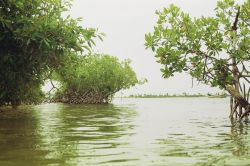Yo-ho-ho mateys! Me hopes ye’ve not yet thrown ye-selves to Davey Jones’ locker over the depressing fishy news of late. Begad, buckos, I could cry enough tears to fill me empty noggin o’ rum twice over … not that I did, mind ye … it’s just the ol’ patch makes me eye water a bit. Arrr …
 But in the interest of putting a positive spin on things, I point you to the climate survival guides recently published by two major conservation groups. One focuses on coral reefs — the “tropical rainforests of the ocean” — and the other on mangroves — actual forests near the oceans (confused yet?). And both offer strategies that could protect these fragile ecosystems in the wake of climate change — even if we can’t reverse climate change itself. Think of the reports as wonkier versions of the Worst Case Scenario Handbook.
But in the interest of putting a positive spin on things, I point you to the climate survival guides recently published by two major conservation groups. One focuses on coral reefs — the “tropical rainforests of the ocean” — and the other on mangroves — actual forests near the oceans (confused yet?). And both offer strategies that could protect these fragile ecosystems in the wake of climate change — even if we can’t reverse climate change itself. Think of the reports as wonkier versions of the Worst Case Scenario Handbook.
The coral report (PDF) calls for the adoption of a range of measures that could mitigate the damage to coral weakened by warming waters, including:
- improved reef monitoring;
- marine protection areas;
- transplanting healthy coral to degraded reefs; and
- coastal and fishing management schemes.
“We need to minimise human impacts such as pollution, overfishing or unsustainable coastal developments,” says coral-report author Gabriel “I’m only mentioning him because of his awesome last name” Grimsditch.
The authors of the mangrove report (PDF) also highlight strategies for protection including:
- identify and protect areas naturally positioned to survive climate change;
- manage human demands on the plantations;
- establish green belts and buffer zones to allow mangrove migration; and
- restore degraded areas that have displayed resilience to climate shifts.
‘Tis true we’re talking about two ecosystems that have been, over the last few decades, almost bulldozed into nonexistence, inasmuch as underwater areas can be bulldozed. (According to the BBC article, “over the past 50 years, an estimated one-third of the world’s mangrove forests have been cleared for fuel, coastal developments, or farming.”) But at least these reports are looking at strategies to protect what’s left — rather than a countdown to apocalypse.
 But in the interest of putting a positive spin on things, I point you to the
But in the interest of putting a positive spin on things, I point you to the 
